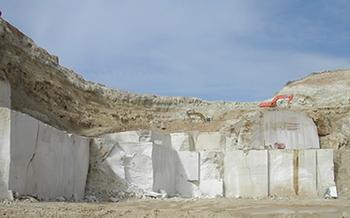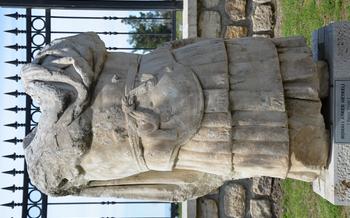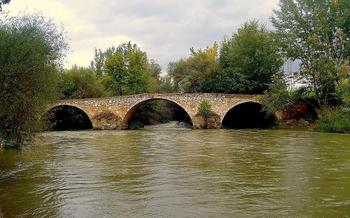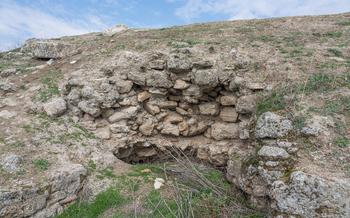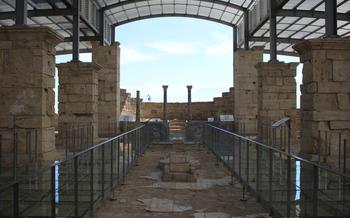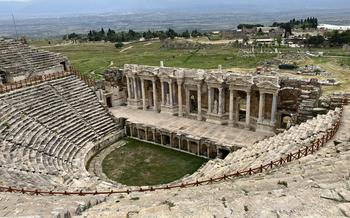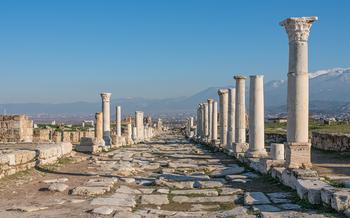
Eskihisar Stone Bridge
- The Antiquity of Eskihisar Stone Bridge
- Location and Accessibility
- Architectural Marvel
- Historical Significance
- Preservation and Restoration
- Surrounding Landscape
- Picnic Spot
- Cultural Significance
- Insider Tip:
- Local Cuisine
- Nearby Attractions
- Photography Opportunities
- Souvenirs and Handicrafts
- Local Festivals and Events
- Guided Tours
- Insider Tip
The Antiquity of Eskihisar Stone Bridge
The Eskihisar Stone Bridge stands as a testament to the rich history and architectural prowess of ancient civilizations. Built in the 2nd century AD, during the Roman Empire's reign, the bridge played a crucial role in connecting the ancient city of Laodicea on the Lycus to the surrounding regions. Laodicea, renowned for its textile industry, commerce, and medical school, flourished as a significant trade hub in antiquity.
The bridge's construction reflects the advanced engineering skills of the Romans. Constructed using locally sourced stone, the bridge features a remarkable series of arches that gracefully span the Lycus River. The bridge's design showcases the Romans' mastery of arch construction, allowing them to create a structure that has endured the test of time and natural elements for over 18 centuries.
Location and Accessibility
The Eskihisar Stone Bridge is situated at the coordinates of 37°51'7"N and 28°58'6"E. It lies in the picturesque town of Eskihisar, which is part of the Denizli Province in Turkey. The bridge is conveniently located within easy reach of several major cities and towns in the region. Denizli, the provincial capital, is approximately 50 kilometers away, while Pamukkale, famous for its travertine terraces, is about 25 kilometers distant.
Reaching the Eskihisar Stone Bridge is relatively straightforward. Visitors can take advantage of the well-connected transportation network in the area. Regular bus services operate from Denizli and Pamukkale to Eskihisar, making it easy for travelers to get to the bridge. Alternatively, renting a car offers the flexibility to explore the region at your own pace. The bridge is situated a short walk from the main road, allowing for a leisurely stroll amidst the natural surroundings.
Architectural Marvel
The Eskihisar Stone Bridge stands as a testament to the architectural prowess of ancient civilizations. Its unique design features a series of arches that elegantly span the river, creating a visually striking and structurally sound masterpiece. The bridge's arches are constructed using the voussoir technique, where wedge-shaped stones are arranged in a radiating pattern, distributing the weight of the structure evenly and ensuring its stability. The skillful use of local materials, such as limestone and basalt, adds to the bridge's authenticity and blends seamlessly with the surrounding landscape.
The bridge's construction showcases the advanced engineering knowledge of the ancient builders. The arches are designed to withstand the force of the river's current and the weight of passing traffic, demonstrating a deep understanding of structural mechanics. The use of corbels, or projecting stones, on the bridge's piers further enhances its structural integrity by redirecting the force of the water away from the bridge's foundations.
The Eskihisar Stone Bridge not only served as a vital transportation link but also played a significant role in connecting different parts of the ancient city. It facilitated the movement of people and goods, promoting trade and cultural exchange within the region. Its strategic location and impressive architecture made it a symbol of the city's prosperity and power, leaving an enduring legacy that continues to captivate visitors to this day.
Historical Significance
The Eskihisar Stone Bridge stands as a testament to its historical significance, having played a crucial role in ancient trade routes and transportation. Its strategic location allowed for the smooth movement of goods and people between the cities of Laodicea on the Lycus and Philadelphia. The bridge facilitated trade and cultural exchange, contributing to the region's economic and cultural development. Historical records mention the bridge as a key crossing point for armies and travelers, witnessing significant events and the passage of prominent figures throughout history. Moreover, its designation as a UNESCO World Heritage Site further underscores its outstanding universal value and the need for its preservation for future generations.
Preservation and Restoration
Over the centuries, the Eskihisar Stone Bridge has faced the relentless test of time and natural elements. Despite its resilience, preserving this architectural marvel has required ongoing efforts and restoration projects. Recognizing its historical significance, authorities and organizations have collaborated to ensure its structural integrity and longevity.
Challenges in maintaining the bridge's stability arise from its age and exposure to environmental factors. The weight of passing vehicles, shifting river currents, and occasional seismic activity have necessitated regular inspections and repairs. Skilled artisans and engineers have employed traditional techniques, using local materials to maintain the bridge's authenticity while reinforcing its foundations.
The importance of preserving historical landmarks like the Eskihisar Stone Bridge extends beyond their physical existence. These structures represent the cultural heritage of a region and serve as tangible links to the past. By safeguarding these landmarks, we ensure that future generations can appreciate and learn from the remarkable achievements of our ancestors.
Ongoing conservation projects and initiatives focus on preserving the bridge's unique features while minimizing the impact of modern interventions. The use of sustainable materials and techniques aims to maintain the bridge's original character while ensuring its resilience against future challenges.
Preserving the Eskihisar Stone Bridge is a testament to the value we place on our cultural heritage. It reminds us that history is not merely a collection of dates and events but a tangible reality that shapes our present and inspires our future.
Surrounding Landscape
The picturesque setting of the Eskihisar Stone Bridge amidst natural beauty is a sight to behold. The lush green surroundings and serene atmosphere create a tranquil ambiance that invites relaxation and contemplation. The bridge stands majestically over the meandering river, offering panoramic views of the valley and the surrounding landscapes. The vibrant colors of the water, the lush vegetation, and the clear blue sky create a breathtaking backdrop for capturing stunning photographs. Whether you're a nature enthusiast, a photographer, or simply someone seeking a peaceful retreat, the Eskihisar Stone Bridge and its surroundings offer a truly enchanting experience.
Picnic Spot
The Eskihisar Stone Bridge has become a popular picnic spot for locals and tourists alike. Designated areas with tables, benches, and other facilities provide a comfortable and scenic environment to enjoy a leisurely meal outdoors. Pack a picnic basket filled with local delicacies, such as fresh fruits, olives, cheese, and bread, to savor the flavors of the region amidst the tranquil surroundings. The lush green landscape, the gentle breeze, and the calming sound of the river create an idyllic atmosphere for a memorable picnic experience.
Cultural Significance
The Eskihisar Stone Bridge stands as a proud testament to Turkish cultural heritage, embodying the region's rich history and traditions. Locals hold the bridge in high esteem, weaving local legends, folklore, and stories around its ancient stones. These tales, passed down through generations, add a layer of enchantment to the bridge, making it not just a historical landmark but also a source of cultural pride.
The bridge has served as a muse for countless artists, writers, and musicians, inspiring them to create works that capture its essence and significance. Local artisans draw inspiration from the bridge's unique architecture and surroundings, crafting beautiful handicrafts and souvenirs that reflect the region's cultural heritage. Visitors can find these unique items at nearby shops, supporting local artisans and preserving traditional crafts.
Insider Tip:
Combine your visit to the Eskihisar Stone Bridge with a trip to the nearby Laodicea on the Lycus, an ancient city with well-preserved ruins. This combination allows you to delve deeper into the region's history and culture, exploring the bridge's role in ancient trade routes and witnessing the grandeur of the city it once served.
Local Cuisine
Your visit to the Eskihisar Stone Bridge offers an excellent opportunity to savor the delights of traditional Turkish cuisine. In the vicinity of the bridge, you'll find an array of restaurants and eateries serving a variety of mouthwatering dishes that will tantalize your taste buds.
Indulge in the smoky and succulent flavors of "kebap," grilled meat skewers that are a staple of Turkish cuisine. The succulent meat, marinated in aromatic spices and cooked to perfection, will leave you craving for more.
For a taste of something different, try "pide," a boat-shaped flatbread topped with a variety of delectable fillings. Choose from a selection of meats, vegetables, and cheeses, all baked to perfection in a traditional stone oven.
The flavors of Turkish cuisine are derived from a blend of fresh ingredients, aromatic herbs, and spices. Don't miss out on the opportunity to sample the local cuisine and experience the culinary delights that Turkey has to offer.
To find the most authentic and affordable eateries, venture off the beaten path and explore the local markets and side streets. Ask for recommendations from your hotel concierge or a local guide, who can direct you to hidden gems that serve delicious and authentic Turkish cuisine.
Nearby Attractions
While visiting the Eskihisar Stone Bridge, take advantage of the opportunity to explore other historical sites and landmarks in the vicinity. The ancient city of Laodicea on the Lycus, with its well-preserved ruins, is a must-see. Immerse yourself in the rich history of this ancient city, once a prominent center of Christianity and home to one of the Seven Churches of Revelation. The ruins include an impressive theater, a stadium, and various temples and churches.
The Denizli Archaeological Museum is another worthwhile attraction, housing a vast collection of artifacts from the region, including sculptures, pottery, and coins. Learn about the fascinating history and culture of Denizli and its surrounding areas through these exhibits.
For a glimpse into the region's natural beauty, visit the Pamukkale Travertines, a UNESCO World Heritage Site. Marvel at the cascading white terraces and turquoise pools formed by thermal springs. Take a dip in the warm mineral-rich waters and enjoy the breathtaking views of the surrounding landscape.
Combine these attractions with your visit to the Eskihisar Stone Bridge to create a comprehensive and enriching travel experience in Denizli.
Photography Opportunities
The Eskihisar Stone Bridge is a photographer's paradise, offering countless opportunities to capture stunning images. The bridge's picturesque setting against the backdrop of the lush green valley and meandering river creates a perfect canvas for photography enthusiasts. The best time to visit the bridge for photography is during the golden hours of sunrise and sunset when the warm light casts an ethereal glow on the ancient structure.
To capture the bridge's grandeur, position yourself at a low angle to emphasize its towering arches and the intricate details of its stonework. Experiment with different perspectives, such as shooting from the riverbank or from above, to create dynamic compositions. The surrounding landscape provides ample opportunities for wide-angle shots that showcase the bridge within its natural context.
Don't forget to play with different shutter speeds to convey a sense of movement or stillness. For a dramatic effect, use a slow shutter speed to blur the flowing water beneath the bridge, creating a sense of tranquility. Conversely, a fast shutter speed can freeze the water's motion, capturing the energy and vitality of the river.
Whether you're a professional photographer or simply enjoy capturing beautiful moments, the Eskihisar Stone Bridge is a treasure trove of photographic opportunities. So bring your camera, unleash your creativity, and let the bridge's timeless beauty inspire your shots.
Souvenirs and Handicrafts
As you stroll through the charming streets near the Eskihisar Stone Bridge, take advantage of the opportunity to shop for unique and authentic souvenirs and handicrafts. Local artisans display their creations, offering a glimpse into the region's rich cultural heritage. From intricately woven carpets to hand-painted ceramics, you'll find a treasure trove of items to cherish as mementos of your trip.
Support local artisans by purchasing their beautiful creations. Not only will you take home a piece of Turkish craftsmanship, but you'll also contribute to preserving traditional crafts that have been passed down through generations.
To find the best quality and prices, explore the local markets and shops. You'll discover a variety of items to suit every taste and budget. Whether you're looking for a colorful scarf, a handmade jewelry piece, or a decorative item for your home, you're sure to find something special to take back with you.
Local Festivals and Events
The region surrounding the Eskihisar Stone Bridge is alive with local festivals and events throughout the year, offering visitors a chance to immerse themselves in Turkish culture and traditions. One of the most popular events is the Laodicea Festival, held annually in the summer months. This vibrant festival celebrates the ancient city's rich history and heritage, featuring traditional music, dance performances, and theatrical reenactments of ancient rituals.
Another must-attend event is the Denizli Grape and Wine Festival, held in September. This festival showcases the region's renowned viticulture and viniculture, with local wineries offering tastings of their finest vintages. Visitors can indulge in grape-themed delicacies, enjoy live music, and participate in traditional grape-stomping competitions.
For those interested in history and archaeology, the Laodicea Ancient City Excavation Festival is a unique opportunity to witness ongoing excavations and learn about the latest discoveries. Visitors can join guided tours of the excavation site, interact with archaeologists, and gain insights into the ancient city's fascinating past.
To ensure you don't miss out on these exciting events, it's advisable to plan your visit to coincide with the festival dates. Check local tourism websites or consult with your hotel concierge for detailed information on upcoming events and festivals.
Guided Tours
Enhancing your visit to the Eskihisar Stone Bridge can be made even more rewarding by opting for a guided tour. Knowledgeable guides bring the bridge's history, architecture, and significance to life with their captivating narratives. They provide insights into the ancient city of Laodicea on the Lycus, the bridge's construction, and its role in trade and transportation. Tours typically cover other historical sites in the vicinity, offering a comprehensive exploration of the region's rich heritage.
When selecting a tour operator, it's important to choose reputable companies that prioritize safety, quality, and customer satisfaction. Look for operators that offer various tour options to suit different interests and budgets. Whether you prefer a private tour for a personalized experience or a group tour to socialize with fellow travelers, there are options available to cater to your preferences.
By joining a guided tour, you'll gain a deeper understanding of the Eskihisar Stone Bridge and its historical context. The guides' expertise will enrich your visit and provide you with lasting memories of this remarkable landmark.
Insider Tip
Timing is everything when it comes to capturing the magic of Eskihisar Stone Bridge. For the most serene experience, plan your visit early in the morning as the sun rises, casting a warm glow on the ancient structure and its surroundings. Alternatively, visit just before sunset to witness the sky ablaze with color, creating a picturesque backdrop for your photographs.
Combine your visit to the bridge with a leisurely stroll along the nearby riverbanks, where you can soak in the tranquil atmosphere and capture stunning shots of the bridge from different angles. For a unique perspective, embark on a hot air balloon ride over the valley, offering breathtaking aerial views of the bridge and the surrounding landscape.
Don't miss the opportunity to explore the hidden gem of Gümüşsu Waterfall, located a short distance from the bridge. This enchanting waterfall is a popular spot for locals and offers a refreshing respite from the summer heat. Capture the cascading waters against the backdrop of lush greenery, creating a mesmerizing sight.
Whether you're a history buff, nature enthusiast, or photography aficionado, Eskihisar Stone Bridge promises an unforgettable experience. Embrace the local culture, savor the delicious cuisine, and create lasting memories in this captivating corner of Turkey.
